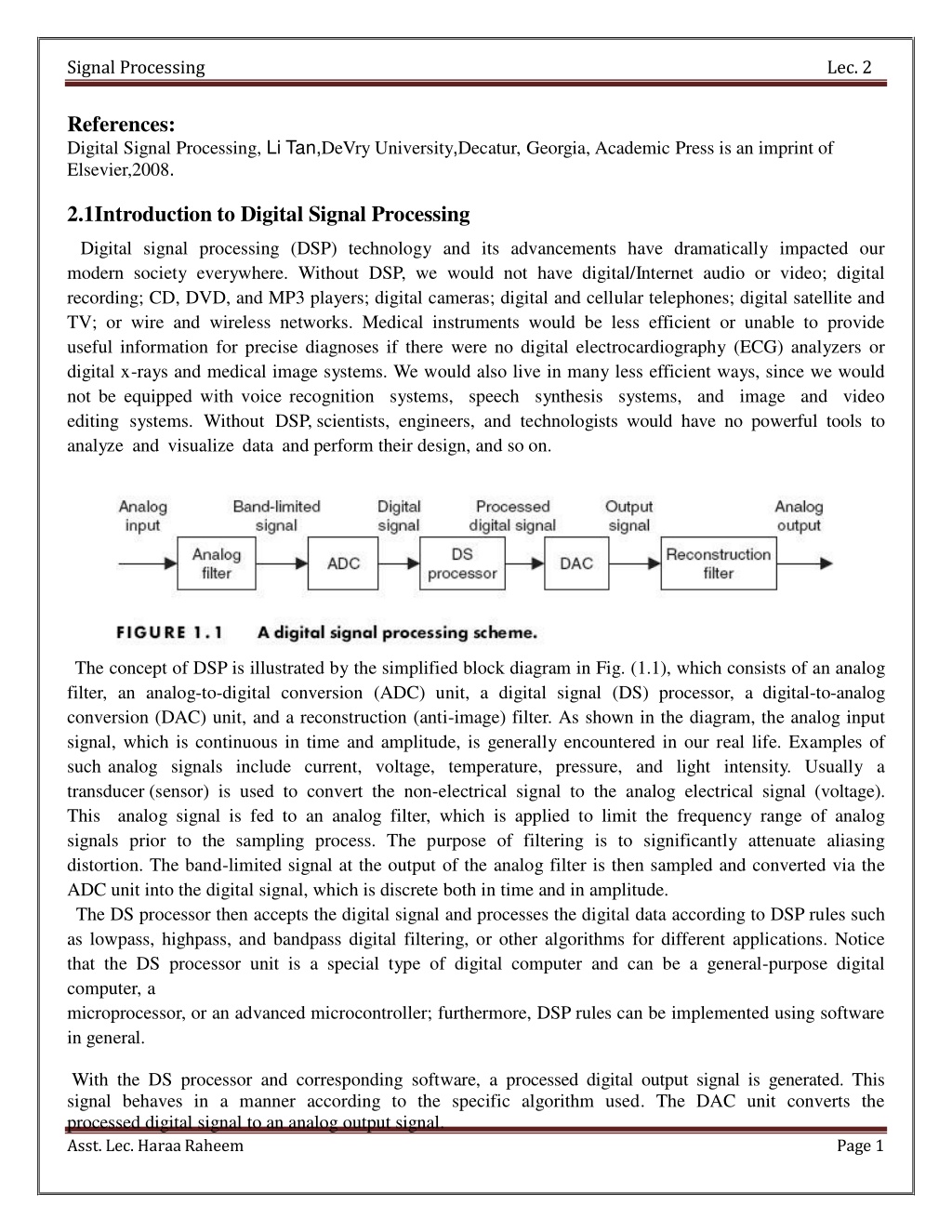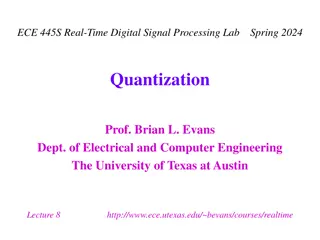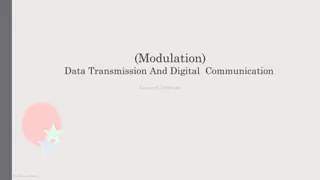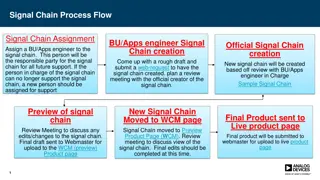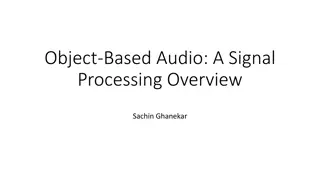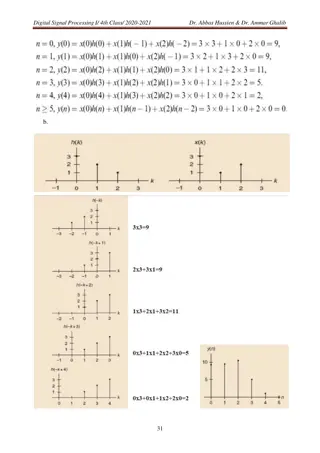Understanding Digital Signal Processing in Modern Society
Digital Signal Processing (DSP) technology has revolutionized modern society by enabling advancements in areas such as audio, video, communication, medical diagnostics, image processing, and data analysis. This technology involves converting analog signals to digital, applying digital algorithms for processing, and then reconverting the signals back to analog. Basic concepts such as digital filtering play a crucial role in enhancing signals and removing noise for various applications.
- Digital Signal Processing
- Technology Impact
- Modern Society
- Analog-to-Digital Conversion
- Digital Filtering
Download Presentation

Please find below an Image/Link to download the presentation.
The content on the website is provided AS IS for your information and personal use only. It may not be sold, licensed, or shared on other websites without obtaining consent from the author. Download presentation by click this link. If you encounter any issues during the download, it is possible that the publisher has removed the file from their server.
E N D
Presentation Transcript
Signal Processing Lec. 2 References: Digital Signal Processing, Li Tan,DeVry University,Decatur, Georgia, Academic Press is an imprint of Elsevier,2008. 2.1Introduction to Digital Signal Processing Digital signal processing (DSP) technology and its advancements have dramatically impacted our modern society everywhere. Without DSP, we would not have digital/Internet audio or video; digital recording; CD, DVD, and MP3 players; digital cameras; digital and cellular telephones; digital satellite and TV; or wire and wireless networks. Medical instruments would be less efficient or unable to provide useful information for precise diagnoses if there were no digital electrocardiography (ECG) analyzers or digital x-rays and medical image systems. We would also live in many less efficient ways, since we would not be equipped with voice recognition systems, speech synthesis systems, and image and video editing systems. Without DSP, scientists, engineers, and technologists would have no powerful tools to analyze and visualize data and perform their design, and so on. The concept of DSP is illustrated by the simplified block diagram in Fig. (1.1), which consists of an analog filter, an analog-to-digital conversion (ADC) unit, a digital signal (DS) processor, a digital-to-analog conversion (DAC) unit, and a reconstruction (anti-image) filter. As shown in the diagram, the analog input signal, which is continuous in time and amplitude, is generally encountered in our real life. Examples of such analog signals include current, voltage, temperature, pressure, and light intensity. Usually a transducer (sensor) is used to convert the non-electrical signal to the analog electrical signal (voltage). This analog signal is fed to an analog filter, which is applied to limit the frequency range of analog signals prior to the sampling process. The purpose of filtering is to significantly attenuate aliasing distortion. The band-limited signal at the output of the analog filter is then sampled and converted via the ADC unit into the digital signal, which is discrete both in time and in amplitude. The DS processor then accepts the digital signal and processes the digital data according to DSP rules such as lowpass, highpass, and bandpass digital filtering, or other algorithms for different applications. Notice that the DS processor unit is a special type of digital computer and can be a general-purpose digital computer, a microprocessor, or an advanced microcontroller; furthermore, DSP rules can be implemented using software in general. With the DS processor and corresponding software, a processed digital output signal is generated. This signal behaves in a manner according to the specific algorithm used. The DAC unit converts the processed digital signal to an analog output signal. Asst. Lec. Haraa Raheem Page 1
Signal Processing Lec. 2 1.2 Basic Digital Signal Processing 1.2.1 Digital Filtering Consider the situation shown in Fig. (1.2), of a digitized noisy signal containing a useful low-frequency signal and noise that occupies all of the frequency range. After ADC, the digitized noisy signal x(n), where n is the sample number, can be enhanced using digital filtering. Since our useful signal contains the low- frequency component, the high frequency components above that of our useful signal are considered as noise, which can be removed by using a digital lowpass filter. After processing the digitized noisy signal x(n), the digital lowpass filter produces a clean digital signal y(n). The cleaned signal y(n) is applied to another DSP algorithm for a different application or convert it to the analog signal via DAC and the reconstruction filter. The digitized noisy signal and clean digital signal, respectively, are plotted in Fig. (1.3), where the top plot shows the digitized noisy signal, x(n), while the bottom plot demonstrates the clean digital signal ,y(n), obtained by applying the digital lowpass filter. Asst. Lec. Haraa Raheem Page 2
Signal Processing Lec. 2 1.2.2 Signal Frequency (Spectrum) Analysis As shown in Figure 1.4, certain DSP applications often require that time domain information and the frequency content of the signal be analyzed. Figure 1.5 shows a digitized audio signal and its calculated signal spectrum (frequency content), defined as the signal amplitude versus its corresponding frequency. It is also called fast Fourier transform (FFT). Figure 1.5 Audio signal and its spectrum 3. Digital Signal Processing Applications The list below by no means covers all DSP applications. Many more areas are increasingly being explored by engineers and scientists. Applications of DSP techniques will continue to have profound impacts and improve our lives. 1. Digital audio and speech: Digital audio coding such as CD players, digital crossover, digital audio equalizers, digital stereo and surround coding, data compression and encryption, speech synthesis and speech recognition. 2. Digital telephone: Speech recognition, synthesizers, DTMF (dual-tone multi frequency) generation and detection, answering machines. 3. Automobile industry: Active noise control systems, active suspension systems, digital audio and radio, digital controls. Asst. Lec. Haraa Raheem sound, noise reduction systems, speech high-speed modems, echo cancellation, speech Page 3
Signal Processing Lec. 2 4. Electronic communications: Cellular phones, digital telecommunications, wireless LAN (local area networking), satellite communications. 5. Medical imaging equipment: ECG analyzers, cardiac monitoring, medical imaging and image recognition, digital x-rays and image processing. 6. Multimedia: Internet phones, audio, and video; hard disk drive electronics; digital pictures; Asst. Lec. Haraa Raheem Page 4
